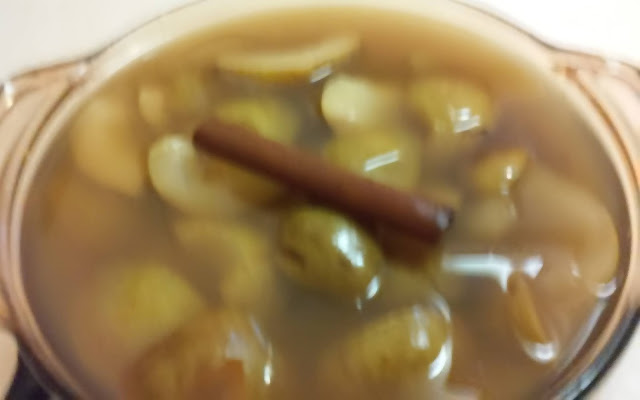c 2020, PL dba lovepat press, Benton AR USA
Monday, August 17, 2020
Between college terms—getting home projects started
c 2020, PL dba lovepat press, Benton AR USA
Saturday, August 8, 2020
Poaching unripe ground fall pears
I
swore I wouldn’t do anything with this season’s pear crop and have offered the
fruit to several folks. However, the day before son Eric came to mow the acre,
I picked up the ground-fall pears—small, unripe—so he wouldn’t have to mow over
them. They filled the bottom of a plastic dishpan which I brought up to the
house. What could be done with them, I wondered, besides throwing them out for
the rabbits and squirrels and chipmunks? My curiosity got the better of me and
I went to Google: how about poaching them, eHow.com’s article suggested. The
only food I’d ever heard of poaching were eggs, which I never actually did.
So I
bit. Washed the fruit, layered one deep in a Dutch oven, covered them with
water, set the pot on the stove, then read the directions: “Steep the pears in
a fragrant bath of fruit-forward white wine (no), water, sugar, scraped vanilla
bean (dumped a bit of liquid vanilla instead), and cinnamon (one stick).” I
tasted the “water.” Not sweet enough: added more sugar, then the last of the
maple syrup, the rest of a bottle of cranberry juice, and an instant package of
Tang. Mixed. Tasted better, sweeter.
Turned
on the burner and when the liquid boiled, I lowered the heat so it could
“simmer for 45 minutes.” Nothing about covering the pot, so I didn’t. But I set
two timers and stayed fairly close to the kitchen area during that time.
When
the timers sounded, I turned off the heat, pulled out from a lower cabinet a
plastic-wrapped round silver-ish tray that I’d never used in the fourteen years
I’ve lived here, covered it with a drying towel and placed each pear on it. The
skins were shiny instead of dull like when they went into the brew. The liquid
had cooked down to a small amount.
pears after poaching
After
they cooled, I pulled out a cutting board and a serrated knife and began
cutting each in quarters, removing the stem/seeds/hard spots (rare). Of course,
I had to taste the first one. It was semi sweet, both skin and pulp. When all
were cut, I plopped them back into what liquid was left, pulled down the
largest casserole dish I owned. Sure enough, it held both the fruit and the
juice. But barely. If I’d trembled while putting the covered bowl into the
fridge, it would likely have spilled. It didn’t.
The
recipe continues: “The poached pears can be served warm, cold or at room
temperature, by themselves or accompanied with poaching syrup (?). Vanilla-bean
ice cream and some additional wine for zing add an extra note of indulgence.”
Probably not, but perhaps. When my Florida son comes for the weekend, we’ll see
if my experiment was worth crowing about. And perhaps repeating.





